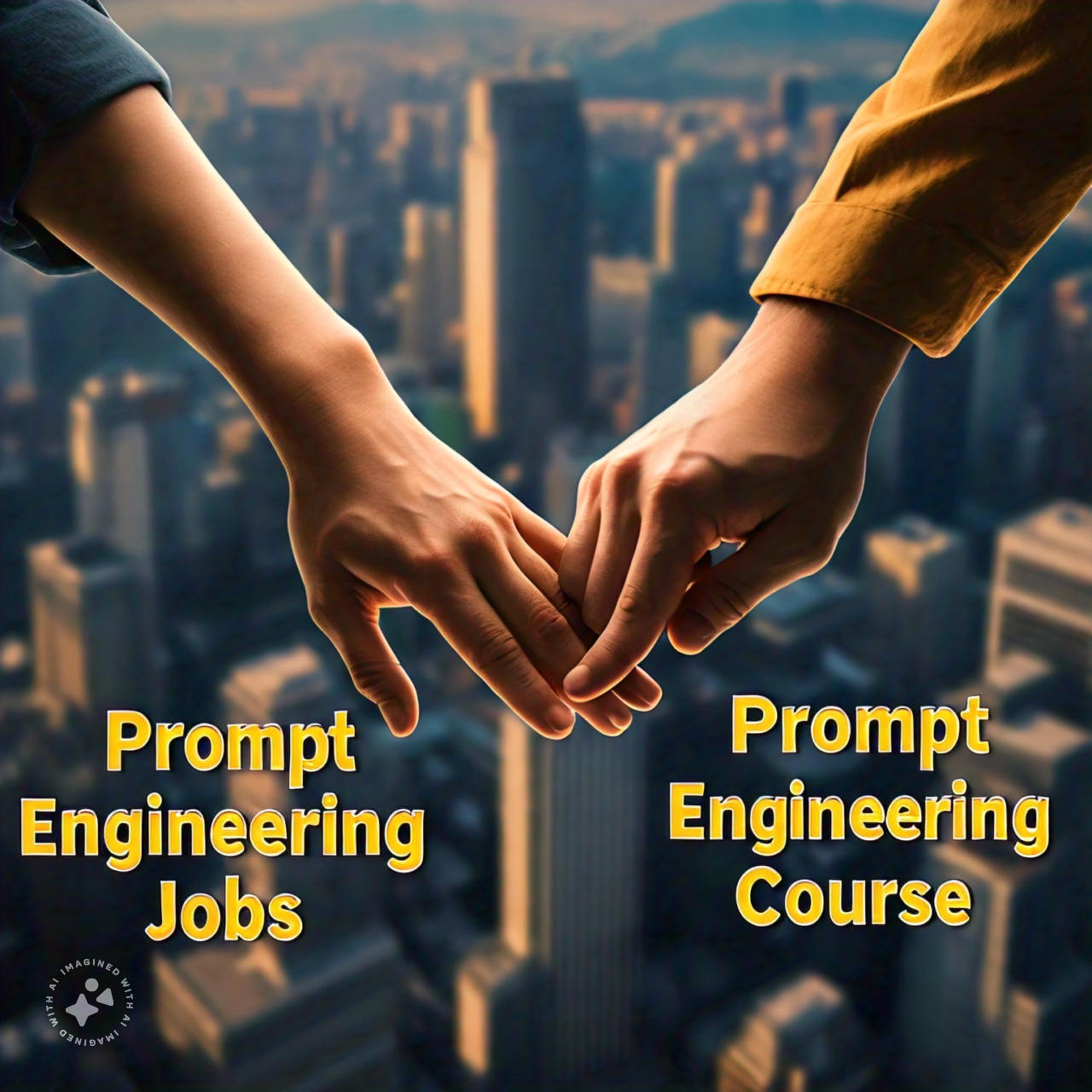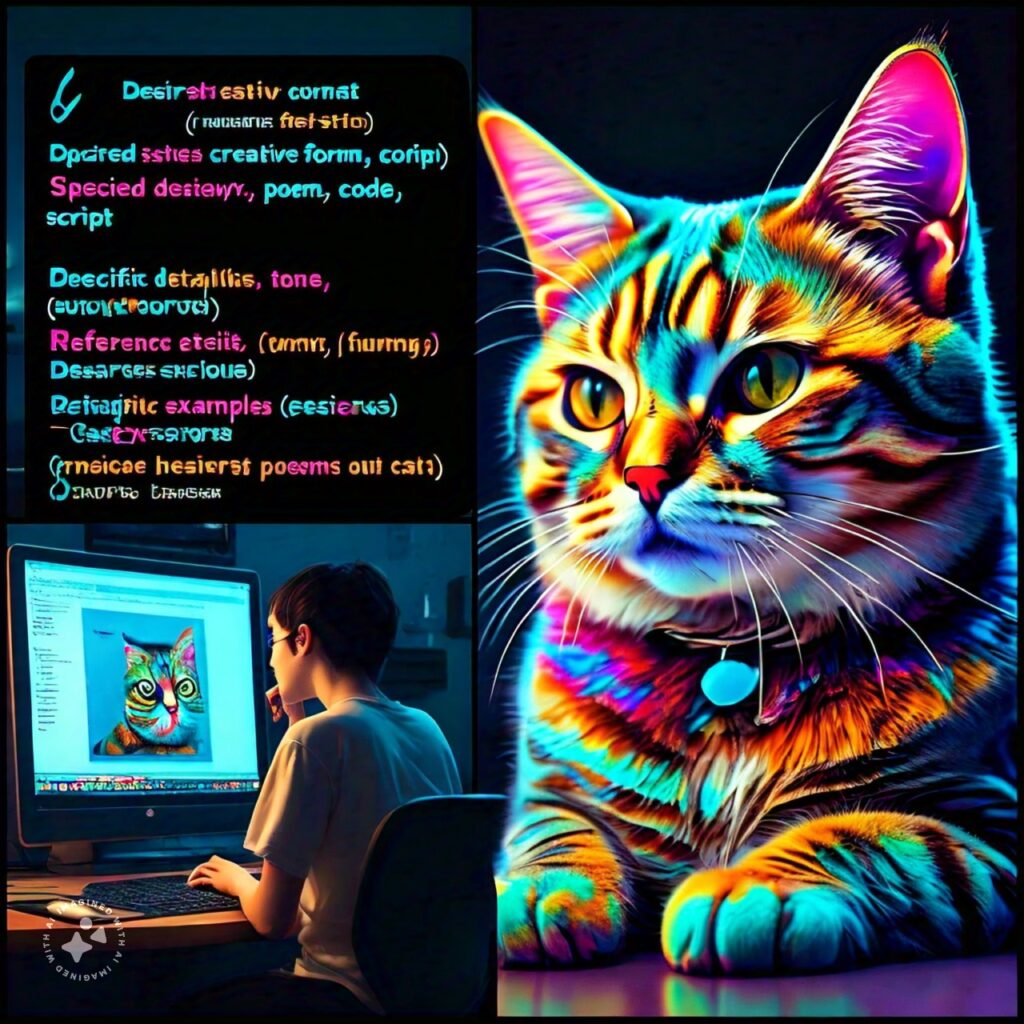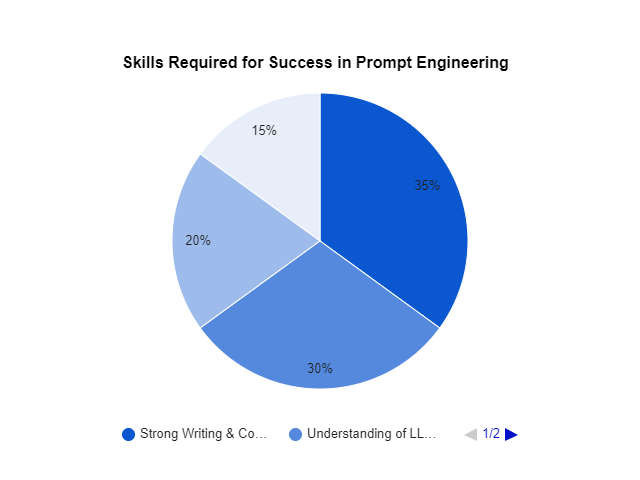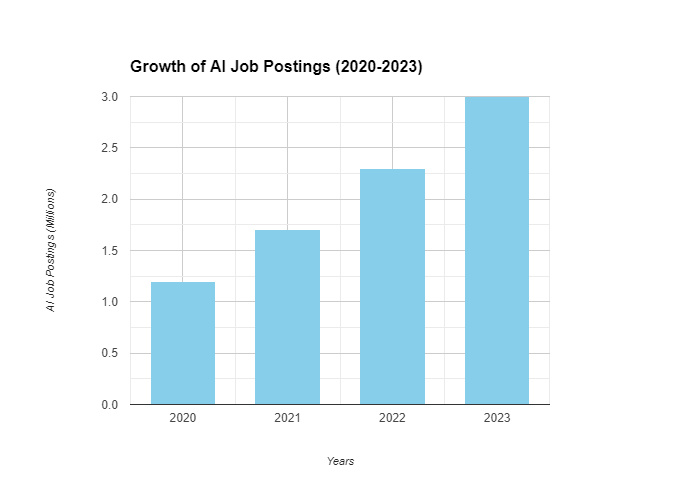
Imagine a world where AI can write captivating poems, translate languages with nuanced accuracy, and even generate lines of code.
This isn't science fiction; it's the reality we're living in thanks to the emergence of Large Language Models (LLMs).
These complex AI systems, like GPT-3 and Bard, are trained on massive datasets of text and code, allowing them to perform a wide range of tasks with remarkable skill.
But even the most sophisticated LLMs require guidance to unlock their full potential. That's where prompt engineering comes in.
 Caption: Break writer's block: AI sparks inspiration with creative text formats.
Caption: Break writer's block: AI sparks inspiration with creative text formats.Have you ever wondered how AI can seemingly conjure up creative text formats, translate languages with near-perfect fluency,
or even answer your questions in an informative way? The answer lies in the art of prompt engineering.
Not long ago, I was tasked with writing a comprehensive report on a highly technical topic. The research was extensive,
but crafting a clear and engaging narrative seemed daunting. Then, I discovered the power of prompt engineering.
By carefully crafting prompts that outlined the desired structure, tone, and key points, I was able to guide an LLM to generate a draft that exceeded my expectations.
It was a revelation, and it opened my eyes to the immense potential of this field.
Picture this: you're a sculptor, meticulously molding a formless block of clay into a masterpiece. That's essentially what prompt engineers do,
except their medium is language, and their tools are carefully crafted instructions that shape the outputs of powerful AI models.
Large Language Models (LLMs) have rapidly transformed various industries, from marketing and content creation to customer service and scientific research.
Their ability to process and generate human-quality text has opened up a world of possibilities. However,
LLMs require specific instructions to perform these tasks effectively. This is where prompt engineering comes into play.
Prompt engineering is the art of crafting prompts, which are essentially sets of instructions that guide LLMs toward desired outputs.
By understanding the capabilities and limitations of LLMs, prompt engineers can create prompts that unlock their full potential,
leading to the generation of creative text formats, accurate translations, informative answers, and even code.
The demand for skilled prompt engineers is growing rapidly as businesses and organizations recognize the immense potential of LLMs.
These professionals play a crucial role in shaping the future of AI, ensuring that these powerful tools are used effectively and ethically.
According to a recent study, the global AI market is expected to reach $1.8 trillion by 2032, with a significant portion of this growth driven by the increasing adoption of LLMs.
This surge in demand creates exciting career opportunities for individuals who possess the necessary skills and knowledge in prompt engineering.
https://www.youtube.com/watch?v=tkX0EfNl4Fc
This video provides a comprehensive introduction to prompt engineering, covering key concepts, best practices, and different prompting techniques.
Problem 1: Lack of Awareness and Understanding
While the potential of Large Language Models (LLMs) has captured the public imagination, there are still
several misconceptions surrounding the field of prompt engineering, the art of crafting instructions that guide these AI models.
 Caption: Stuck for words? Let AI help craft your purrfect poem!
Caption: Stuck for words? Let AI help craft your purrfect poem!One common misconception is that prompt engineering is simply a matter of "telling AI what to do." While prompts do provide instructions,
they are far more nuanced than simple commands. Effective prompt engineering requires a deep understanding of how LLMs work,
their capabilities and limitations, and the ability to translate desired outcomes into clear, concise, and well-structured prompts.
Here's why simply "telling AI what to do" falls short:
- LLMs are not human-like thinkers: They lack the common sense, reasoning abilities, and real-world experiences that humans possess. Prompt engineers need to anticipate potential misinterpretations and provide specific details within the prompts to ensure accurate outputs.
- Nuance matters: LLMs are highly sensitive to the wording and structure of prompts. Subtle changes in phrasing, sentence order, or even punctuation can significantly alter the resulting output.
- Creativity plays a crucial role: Beyond providing basic instructions, effective prompts often incorporate creative elements like metaphors, analogies, and specific examples to guide the LLM towards generating unique and engaging content.
Diverse Applications of Prompt Engineering:
Despite the misconceptions, prompt engineering is rapidly transforming various industries, demonstrating its immense potential beyond simply "telling AI what to do."
Here are some real-world examples:
- Content Creation: Prompt engineers can craft prompts to generate different creative text formats like poems, scripts, musical pieces, email, letters, etc., significantly streamlining the content creation process for marketing teams, writers, and even musicians.
- Marketing and Advertising: Personalized marketing messages, targeted ad copy, and even product descriptions can be generated using prompt engineering, allowing businesses to tailor their communication to specific audiences with greater accuracy and efficiency.
- Customer Service: Chatbots powered by LLMs and guided by effective prompts can provide 24/7 customer support, answer frequently asked questions, and even handle basic troubleshooting tasks, reducing wait times and improving customer satisfaction.
- Scientific Research: Prompt engineering can be used to analyze vast amounts of scientific data, identify patterns, and even generate hypotheses, accelerating research processes and potentially leading to groundbreaking discoveries.
 Caption: From complex prompt to purrfect poem: AI helps you craft compelling content.
Caption: From complex prompt to purrfect poem: AI helps you craft compelling content.A recent report by McKinsey & Company highlights the growing impact of AI in various sectors,
with prompt engineering playing a vital role in unlocking the full potential of LLMs across diverse applications.
By understanding the true nature of prompt engineering and its diverse applications, we can move beyond the misconception of simply "telling AI what to do" and
embrace its potential to revolutionize various industries and create a future driven by intelligent and human-guided AI.
Solution 1: Demystifying Prompt Engineering: The Key Skills for Success
While the field of prompt engineering may seem complex, mastering a few key skills can equip you to effectively guide and
unlock the full potential of Large Language Models (LLMs). Here's a breakdown of the essential abilities that pave the way for success in this exciting domain:
 Caption: Unleash your creativity: AI ignites the brainstorming fire.
Caption: Unleash your creativity: AI ignites the brainstorming fire.1. Understanding of LLMs and their capabilities:
- Fundamental knowledge of AI and NLP: A solid grasp of artificial intelligence (AI) principles, particularly Natural Language Processing (NLP), is crucial. This includes understanding how LLMs are trained, the types of data they process, and their strengths and limitations.
- Familiarity with specific LLM architectures: Different LLMs have varying strengths and weaknesses. Knowing the specific LLM you're working with, its underlying architecture, and its intended use cases is essential for crafting effective prompts.
- Staying updated on the latest advancements: The field of AI is constantly evolving, and prompt engineering practices are continuously being refined. Staying informed about the latest research and developments in LLMs is crucial for staying ahead of the curve.
2. Strong Writing and Communication Skills:
- Clarity and conciseness: Prompts need to be clear, concise, and free of ambiguity. This ensures that the LLM accurately interprets your instructions and generates the desired output.
- Ability to tailor language: Effective prompts often require adjusting the tone, style, and level of formality based on the desired outcome. Whether aiming for a factual report, a creative poem, or a persuasive marketing message, your writing skills play a vital role.
- Structuring information effectively: Organizing information logically within the prompt helps the LLM understand the context, relationships between different elements, and the overall goal you're trying to achieve.
 Caption: This pie chart illustrates the key skill areas that contribute to success in prompt engineering, highlighting the importance of a well-rounded skillset.
Caption: This pie chart illustrates the key skill areas that contribute to success in prompt engineering, highlighting the importance of a well-rounded skillset.3. Data Analysis and Problem-Solving Abilities:
- Analyzing LLM outputs: Evaluating the LLM's generated text requires critical thinking and data analysis skills. You need to identify potential biases, factual inaccuracies, or inconsistencies in the output and refine your prompts accordingly.
- Identifying patterns and trends: Understanding the underlying patterns and trends within the data used to train the LLM can help you craft prompts that leverage its strengths and avoid common pitfalls.
- Troubleshooting and iterative improvement: Prompt engineering is an iterative process. Analyzing the LLM's outputs, identifying areas for improvement, and refining your prompts based on these insights are essential for achieving optimal results.
4. Creative Thinking and Adaptability:
- Thinking outside the box: Effective prompts often incorporate creative elements like metaphors, analogies, and specific examples to guide the LLM towards generating unique and engaging content.
- Adapting to different tasks and contexts: Prompt engineering applications are diverse, and the ability to adjust your approach based on the specific task and desired outcome is crucial.
- Embracing experimentation: Don't be afraid to experiment with different prompt structures, wording, and techniques to discover what works best for a particular LLM and task.
Key Components of Prompt Engineering
ComponentDescriptionPrompt DesignCrafting clear, concise, and specific instructions for the LLM.LLM CapabilitiesUnderstanding the strengths and limitations of the chosen LLM.Data and ContextProviding relevant data and context to guide the LLM's response.Evaluation and RefinementIteratively testing and refining prompts based on the LLM's output.Caption: This table breaks down the core components involved in successful prompt engineering, highlighting the importance of each element.
By combining these key skills, prompt engineers act as the bridge between human intent and LLM capabilities.
They craft precise instructions that unlock the potential of these powerful AI models, leading to the generation of accurate, creative, and informative outputs across various fields.
According to a recent report by Forbes, the demand for skilled prompt engineers is expected to surge in the coming years,
fueled by the increasing adoption of LLMs across diverse industries. Mastering these essential skills will position you to thrive in this dynamic and rapidly evolving field.
https://www.youtube.com/watch?v=s4YKMFFiySI&t=60s
This crash course offers a quick overview of prompt engineering, including essential tips for crafting effective prompts and avoiding common pitfalls.
Problem 2: Navigating the Job Market in a New Frontier
While the field of prompt engineering holds immense potential, it's important to acknowledge that it's a relatively new and
evolving domain. This can present challenges for individuals seeking to enter the job market:
 Caption: Teamwork fuels innovation: Join the collaborative world of Prompt Engineering Jobs.
Caption: Teamwork fuels innovation: Join the collaborative world of Prompt Engineering Jobs.Limited Job Title Standardization:
Specific job titles for "prompt engineer" might not be widely adopted yet. This means you may encounter job postings with titles like "AI Content Specialist,"
"NLP Engineer," or "AI Assistant," which still involve prompt engineering tasks.
Emerging Field with Evolving Requirements:
As the field matures, specific skill sets and experience may become more clearly defined. However, currently,
there might be some ambiguity regarding the exact qualifications employers seek in prompt engineering candidates.
Finding Relevant Opportunities:
Traditional job boards might not yet have dedicated sections for prompt engineering positions. This necessitates a more proactive approach to discover relevant opportunities.
Here are some practical tips to effectively navigate the prompt engineering job market:
1. Utilize Relevant Keywords:
- Include keywords like "prompt engineering," "NLP," "AI writing," "LLM interaction," and "large language models" in your resume and cover letters.
- Research specific companies or projects known to utilize prompt engineering and tailor your keywords accordingly.
- Consider using long-tail keywords that demonstrate your understanding of specific prompt engineering applications (e.g., "prompt design for marketing copywriting").
 Caption: This bar graph showcases the significant and consistent rise in AI job postings, including potential opportunities in prompt engineering.
Caption: This bar graph showcases the significant and consistent rise in AI job postings, including potential opportunities in prompt engineering.2. Network with AI and Tech Professionals:
- Attend industry conferences, workshops, and online forums focused on AI and emerging technologies.
- Connect with professionals working in AI research, development, or application to gain insights into the job market and potential opportunities.
- Build relationships with recruiters specializing in AI and tech positions.
3. Explore Job Boards Specializing in AI or Emerging Technologies:
- Platforms like Indeed, LinkedIn, and AngelList often feature job postings related to AI, NLP, and machine learning, which may include prompt engineering opportunities.
- Consider niche job boards dedicated to the AI and tech industry, such as VentureBeat or The Bridge.
- Utilize professional networking platforms like LinkedIn to directly connect with companies actively involved in prompt engineering.
Additional Resources:
- Stay updated on industry news and research publications related to prompt engineering. This demonstrates your passion for the field and keeps you informed about the latest trends and potential job opportunities.
- Consider showcasing your prompt engineering skills through personal projects or contributions to open-source initiatives. This can serve as a valuable portfolio piece and attract potential employers.
Potential Job Titles for Prompt Engineers
Job TitleDescriptionPrompt EngineerSpecific role focused on designing and optimizing prompts for LLMs.NLP EngineerBroader role encompassing prompt engineering tasks alongside other natural language processing activities.AI Content SpecialistRole involving content creation using AI tools, potentially including prompt engineering.AI AssistantEmerging role utilizing AI models like LLMs for various tasks, potentially including prompt engineering.Caption: This table presents various job titles associated with prompt engineering, showcasing its potential reach within the AI and tech fields.
Remember, the prompt engineering job market is rapidly evolving. By actively seeking opportunities, strategically utilizing relevant keywords,
and networking within the AI and tech communities, you can position yourself for success in this exciting and growing field.
https://justoborn.com/prompt-engineering/
No comments:
Post a Comment